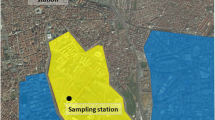Abstract
Emission rates and emission factors of particulate matter and polycyclic aromatic hydrocarbons (PAHs) were determined in the emissions of three prevalent mosquito coil brands available in the market in India, under controlled conditions in an environmental chamber. The emission rates varied between the brands and ranged between 2.0 ± 1.9 to 27.1 ± 1.5 μg h−1 for brand A, 3.4 ± 1.1 to 32.3 ± 1.2 μg h−1 for brand B and 3.1 ± 1.0 to 72.2 ± 1.1 μg h−1 for brand C for different compounds. Five and six ring PAHs were not detected, however four and three ring PAHs dominated. Three ring PAHs contributed 24 %, 42 % and 29 %, while four ring compounds contributed 53 %, 35 % and 61 % to total PAHs in the three brands. Carcinogenic PAH compounds were also present in the emissions, indicating the potential risks associated with the inhalation of coil smoke.

Similar content being viewed by others
References
Abubakar MG, Hassan LG (2007) Toxicological effects of some mosquito coil brands in experimental rats. Internet J Toxicol 4:1–6
Azizi BHO, Henry RL (1991) The effects of indoor environmental factors on respiratory illness in primary school children in Kuala Lumpur. Int J Epidemiol 20(1):144–149
Chen SC, Wong RH, Shiu LJ, Chiou MC, Lee H (2008) Exposure to mosquito coil smoke may be a risk factor for lung cancer in Taiwan. J Epidemiol 18:19–25
Fagbule D, Ekanem EE (1994) Some environmental risk factors for childhood asthma: a case-control study. Ann Trop Paediatr 14(1):15–19
Fan CW, Zhang JJ (2001) Characterization of emissions from portable household combustion devices: particle size distributions, emission rates and factors, and potential exposures. Atmos Environ 35(7):1281–1290
IARC (International Agency for Research on Cancer) (1989). Monographs on the evaluation of the carcinogenic risk of chemicals to humans. In: Occupational exposures in petroleum refining: crude oil and major petroleum fuels vol 45, pp 81–117
Lakhani A (2012) Source apportionment of particle bound polycyclic aromatic hydrocarbons at an industrial location in Agra, India. Sci World J, 2012:781291. doi:10.1100/2012/781291
Lazaridis G, Lofroth G (1987) Pyrolysing insecticidal coils: air pollution by polycyclic aromatic hydrocarbons and other mutagens detected by the Salmonella/microsome test. Environ Pollut 45(4):305–314
Lee SC, Wang B (2006) Characteristics of emissions of air pollutants from mosquito coils and candles burning in a large environmental chamber. Atmos Environ 40:2128–2138
Li CS, Lin WS, Jenq FT (1993) Characterization of outdoor submicron particles and selected combustion sources of indoor particles. Atmos Environ 27B(4):413–424
Liu WK, Sun SE (1988) Ultra-structure changes of tracheal epithelium and alveolar macrophages of rats exposed to mosquito coil smoke. Toxicol Lett 41:145–157
Liu WK, Wong MH, Mui YL (1987) Toxic effects of mosquito coil (a mosquito repellent) smoke on rats. Toxicol Lett 39:223–230
Liu WL, Zhang JF, Hashim JH, Jalaludin J, Hashim Z, Bernard D, Goldstein BD (2003) Mosquito coil emissions and health implications. Environ Health Perspect 111:1454–1460
Nielson PS, Okkels H, Autrup H (1996) Environment air pollution and DNA and NAT2 genotypes on adduct levels carcinogenesis. Atmos Environ 17:1021–1027
Nisbet ICT, LaGoy PK (1992) Toxic equivalency factors (TEFs) for polycyclic aromatic hydrocarbons (PAHs). Regul Toxicol Pharmacol 16(3):290–300
Stabile L, Fuoco FC, Buonanno G (2012) characteristics of particles and black carbon emitted by combustion of incenses, candles and anti-mosquito products. Build Environ 56:184–191
Yuan-yuan ZH-CS, Hong-shuang LJ-GL, Xiao-Li CH-XZ (2009) Emission characteristics of polycyclic aromatic hydrocarbons from mosquito coil burning. Environ Chem 6:020
Zhang Y, Tau S, Shen H, Ma J (2009) Inhalation exposure to ambient polycyclic aromatic hydrocarbons and lung cancer risk of Chinese population. Proc Natl Acad Sci USA 106:21063–21067
Zhang L, Jiang Z, Tong J, Wang Z, Han Z, Zhang J (2010) Using charcoal as base material reduces mosquito coil emissions of toxins. Indoor Air 20:176–184
Acknowledgments
The authors are grateful to the Director, Dayalbagh Educational Institute, Dayalbagh, Agra, and Head, Department of Chemistry for facilities provided and the Department of Science and Technology, New Delhi (DST Project No. SR/S4/AS:282/07) for financial assistance. Mr. Jitendra Dubey acknowledges University Grants Commission (UGC) for Research fellowship for Meritorious students.
Author information
Authors and Affiliations
Corresponding author
Rights and permissions
About this article
Cite this article
Dubey, J., Banerjee, A., Meena, R.K. et al. Characterization of Polycyclic Aromatic Hydrocarbons in Emissions of Different Mosquito Coils. Bull Environ Contam Toxicol 92, 650–654 (2014). https://doi.org/10.1007/s00128-014-1278-6
Received:
Accepted:
Published:
Issue Date:
DOI: https://doi.org/10.1007/s00128-014-1278-6




